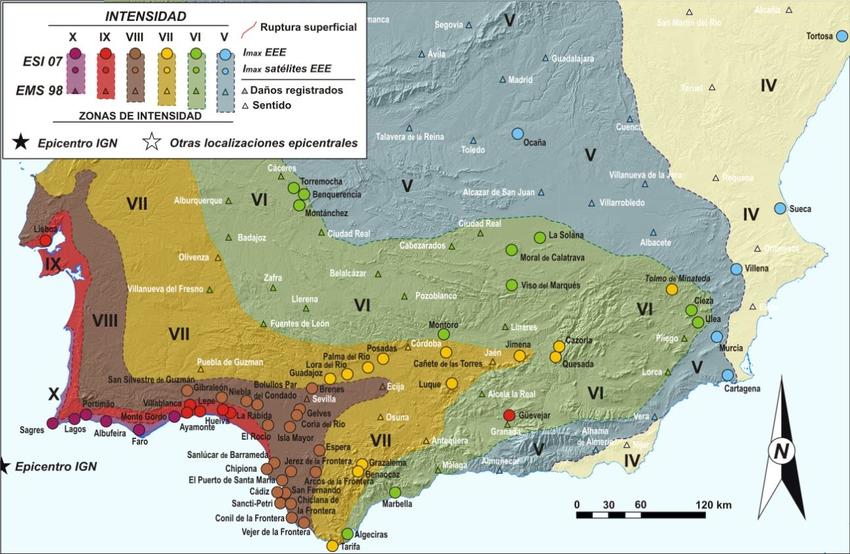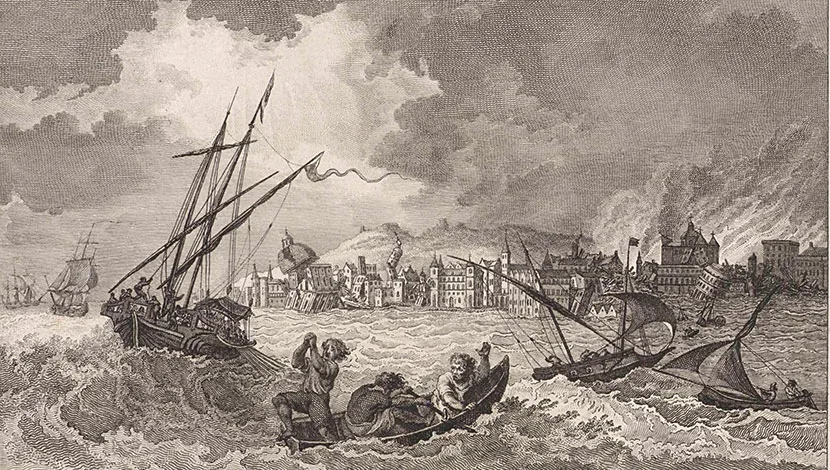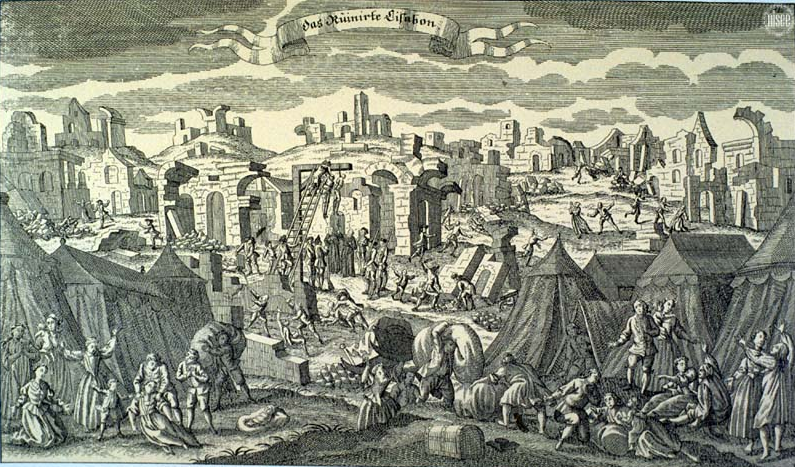Shaking Up History: The 1755 Lisbon Earthquake
The 1755 Lisbon Earthquake wasn’t just a mega quake—it sparked big brain energy and philosophical showdowns. Europe was buzzing with Enlightenment vibes, pushing big questions on knowledge and freedom. Meanwhile, Lisbon got rocked hard, turning a regular day into chaos with tremors, a tsunami, and unrelenting fires. But, here’s the twist: this disaster didn’t just break things; it literally broke old school thinking.Philosophers like Voltaire and Rousseau got into heated debates, throwing shade at the idea that this was the "best of all possible worlds." Instead, they started asking the tough questions: Why would a cool God let such bad stuff happen? Their hot takes pushed people to think more about science and less about divine plans. So, while Lisbon rebuilt smarter cities, the world started building smarter ideas. Today, we’re spotlighting a seismic event that rippled through time—not just through the streets it shook but in the minds it moved. It’s a tale not just of tragedy, but of the birth of modern thought, hidden beneath the rubble of the 1755 Lisbon Earthquake.
Around The World
In the mid-18th century, the globe was a dynamic arena of empires on the move, culture clashes, and intellectual exchanges, marking an era of profound transformation and interaction.
Europe: A Beacon of Enlightenment
Europe was alive with the fervor of the Enlightenment, a remarkable period characterized by a voracious quest for knowledge and an emphasis on rational thought. Philosophers like Voltaire, Rousseau, and Kant were challenging the traditional doctrines of faith and monarchy, advocating for ideas centered around reason, liberty, and equality. Salons, those intellectual gatherings hosted primarily by influential women, became hubs of conversation and debate, crucial for the spread of Enlightenment ideas. The arts and sciences flourished, with breakthroughs that ranged from Newton’s laws to Mozart’s symphonies, echoing a continent’s leap towards modernity.
Fashion was a flamboyant affair that echoed the social and political contrasts of the time. Men and women dressed in elaborate, often ostentatious styles. The wealthy adorned themselves in luxurious fabrics like silk and satin, and wigs, which were not merely for vanity but also a symbol of social status. These extravagant displays of wealth stood in stark contrast to the poverty of the lower classes, who were largely excluded from the wealth generated by colonial exploits and industrial growth.
Asia: Dynasties and Challenges
In Asia, the Qing Dynasty was asserting its might in China, expanding its borders and reinforcing its governance, aiming for a harmonious society rooted in Confucian ideals and bureaucratic control. Meanwhile, in India, the once-mighty Mughal Empire was grappling with a host of challenges. European trading companies, particularly the British East India Company, were transitioning from mere commercial enterprises to political entities, wielding military power and beginning to influence the region’s governance, leading to an erosion of Mughal authority.
Africa: The Shadow of the Slave Trade
Africa faced dark times under the shadow of the transatlantic slave trade, an egregious period of human history marked by suffering and brutality. European powers, driven by greed, exploited African societies, wrenching millions from their homes to toil in far-flung colonies. This devastating commerce in human lives not only dehumanized its victims but also reshaped the continent’s demographics and societies in ways that are still being understood today.
South America: Exploitation by Empires
In South America, the Spanish and Portuguese empires continued their relentless extraction of wealth. The conquests had brought them vast territories rich in resources, from silver mines in Potosí to sugar plantations in Brazil. Indigenous populations were coerced into labor under harsh conditions, often under the encomienda system, which granted colonists the right to their labor in exchange for supposed protection and Christianization.
North America: Seeds of Revolution
In what would soon become the United States, discontent was simmering among the British colonies. The Enlightenment ideals of governance and rights discussed across the Atlantic started taking root here. Intellectuals and political leaders began questioning British authority and discussing separation and self-governance, driven by taxes and laws imposed from afar without local representation. These discussions would soon culminate in a revolutionary war that would shake the foundations of colonial rule.

A Quakeful Reckoning: The Lisbon Earthquake
On November 1, 1755, Lisbon, the flourishing capital of Portugal, was celebrating All Saints’ Day. The city was vibrant, with citizens attending mass and filling the streets, homes brightly adorned with oil lamps and candles in observance of the holy day. Then, at approximately 9:40 in the morning, the earth began to tremble. The first of three massive tremors struck, each one more devastating than the last, lasting several minutes and followed by eerie pauses. These seismic waves were so powerful they were felt as far away as Finland and the Caribbean.
The ground’s violent convulsions were just the beginning. Within an hour of the earthquake, a monstrous tsunami swept through the harbor and downtown, crashing over the sea walls and rushing up the Tagus River. Ships were swept inland, and sea levels rose and fell dramatically, causing further devastation. The destruction was compounded by fires that erupted throughout the city, fueled by the overturned candles and lamps in the densely packed wooden structures of the Lisbon neighborhoods. These fires raged for five days, resisting all efforts to quell them and completing the annihilation that the earthquake and tsunami had begun.
The impact on Lisbon was cataclysmic: about 85% of the city’s buildings were destroyed, including important palaces, churches, and the Royal Ribeira Palace, which housed invaluable historical records that were lost forever. The death toll was staggering, with modern estimates suggesting that between 40,000 to 60,000 people perished in Lisbon alone, a significant portion of its population at the time.
This catastrophe not only shattered the city physically but also spiritually and intellectually. The 1755 Lisbon earthquake struck at the heart of the Enlightenment, a period characterized by faith in human reason and a belief that the world could be understood and controlled through science and rationality. The sheer scale of the disaster, occurring on a religious holy day, prompted a profound crisis of faith and philosophical reflection across Europe.
Prominent philosophers of the day, such as Voltaire and Rousseau, entered into vigorous public debate about the implications of the disaster. Voltaire’s subsequent work, “Poème sur le désastre de Lisbonne” and “Candide,” criticized the optimistic determinism espoused by philosophers like Leibniz and echoed the broader existential questions the earthquake raised. Rousseau responded with letters discussing the relationship between human nature, societal structures, and natural disasters, suggesting that the fatalities were due not to divine will but to the density of population in cities and the folly of humans building large settlements in risk-prone areas.
The 1755 Lisbon earthquake ignited a fervent theological and philosophical debate across Europe, challenging the prevailing views of an omnipotent and benevolent God. How, many wondered, could such a deity allow such indiscriminate destruction, especially on a holy day filled with worshipers? This crisis of faith deeply impacted the Enlightenment—a period marked by a burgeoning reliance on reason and empirical evidence over religious dogma.

Theological and Philosophical Reckoning
After the earthquake, religious leaders and philosophers wrestled with its implications. Traditional explanations that tried to justify the existence of evil in a world ruled by a kind God were found lacking. The earthquake inspired Voltaire to write his famous “Poème sur le désastre de Lisbonne,” which questioned the optimistic philosophy that this was “the best of all possible worlds.” His satirical novel “Candide” further delved into these ideas, using humor and irony to challenge the idea of a world perfectly ordered by a kind deity.
Jean-Jacques Rousseau offered a different take in his writings about the disaster. He argued that the deaths were not due to divine will but to human error—specifically, too many people living too close together in poorly constructed buildings in a dangerous area. Rousseau’s views suggested a shift from seeking divine reasons for natural disasters to understanding them as controllable consequences of human decisions and natural laws.
Shift Towards Scientific Understanding

The earthquake also marked a crucial moment in the scientific study of the earth. It led to the birth of seismology as scientists began to view earthquakes as natural events governed by clear laws, not supernatural occurrences. This shift towards a scientific approach resulted in the first studies of earthquake dynamics and the development of architecture inspired by seismic considerations.
This change was part of a broader movement during the Enlightenment towards secular explanations for natural phenomena, emphasizing research and rational thinking over religious interpretations. The disaster showed the limits of using divine intervention as an explanation, encouraging a more systematic pursuit of knowledge that could help prevent or lessen such disasters in the future.
Post-Lisbon Earthquake: Revolutionary Reconstruction and Legacy

The earthquake’s destruction led to revolutionary changes in urban planning. Under the leadership of the Marquis of Pombal, Lisbon’s reconstruction was quick and scientifically based. Pombal introduced some of the first earthquake-resistant building designs and a strict, grid-like city layout that improved both the look and functionality of Lisbon. These innovative efforts in urban planning and earthquake-resistant construction would later influence architectural and urban strategies around the world.
Furthermore, Pombal used the recovery period to consolidate political power and implement widespread reforms, from economic policies to education, thus modernizing Portugal. His actions shifted Portuguese governance towards a more centralized and secular state, influencing broader European trends towards state-led modernization and structured administrative control.
Thus, the legacy of the Lisbon earthquake is dual: it significantly changed the philosophical landscape of the Enlightenment, challenging how faith and reason could coexist, and it sparked major advancements in scientific and urban planning fields, setting new standards that would shape modern Europe and beyond.
Interested in learning more? We recommend:
- Books: “The Lisbon Earthquake of 1755: Representations and Reactions” by Mark Molesky
- TV Series: “The Age of Voltaire” in the documentary series “The Story of Civilization”
- Websites: Visit the British Library’s online Enlightenment gallery https://www.britishmuseum.org/collection/galleries/enlightenment
- Video Series: “The Enlightenment: Crash Course European History #18” on YouTube https://www.youtube.com/watch?v=NnoFj2cMRLY

